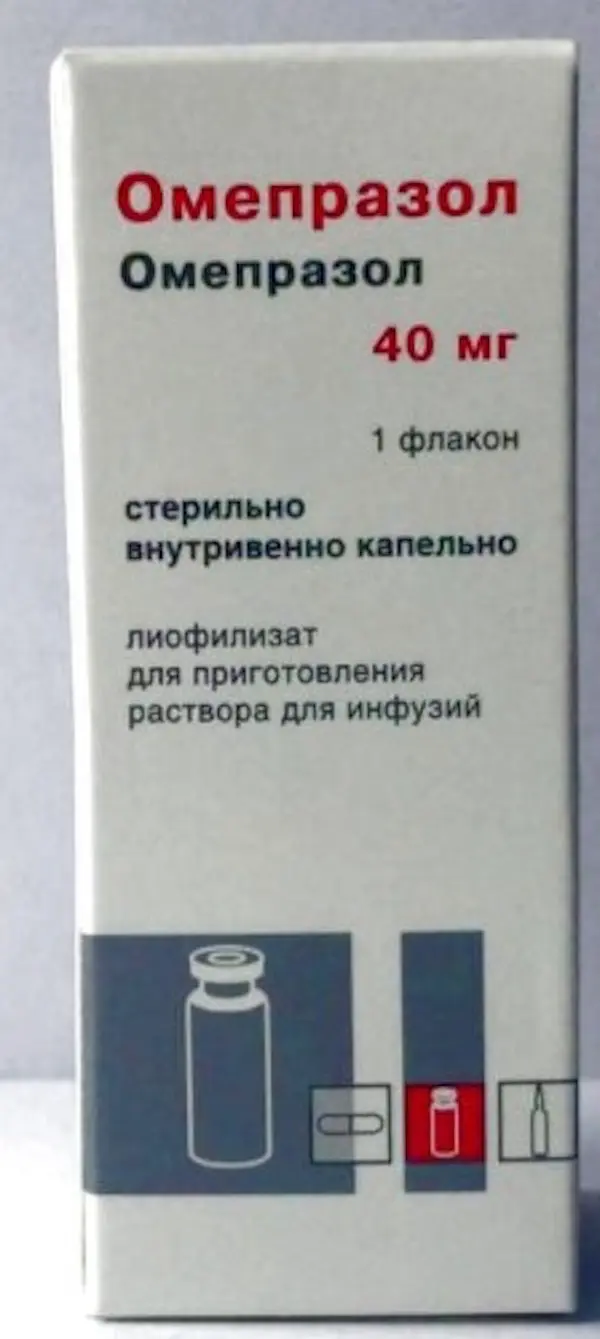Description
Omeprazole Pharmacodynamics
Omeprazole is a racemic mixture of two enantiomers and reduces the secretion of hydrochloric acid in the stomach by specific inhibition of the proton pump in the parietal cells of the gastric mucosa. When administered once daily, the drug acts quickly and blocks the final stage of acid secretion in the stomach, regardless of the nature of the irritant.
Omeprazole is a weak base and accumulates and converts to its active form in the acidic environment of the secretory tubules of the parietal cells of the gastric mucosa, where it inhibits the enzyme H+/K+- ATPase (proton pump).
Intravenous administration of omeprazole causes dose-dependent inhibition of hydrochloric acid secretion in the human stomach. Intravenous administration of 40 mg omeprazole is recommended to achieve rapid reduction of gastric acidity. The antisecretory effect is maintained for 24 hours.
The degree of inhibition of hydrochloric acid secretion is proportional to the area under the concentration-time curve (AUC) of omeprazole, but does not depend on the immediate plasma concentration of the drug.
No development of tachyphylaxis has been observed during therapy with omeprazole.
Effect on Helicobacter pylori
Helicobacter pylori in combination with increased hydrochloric acid production is an important factor in the pathogenesis of peptic ulcer disease, including peptic ulcer and duodenal ulcer. H. pylori is also a cause of gastritis, including atrophic gastritis, which is associated with an increased risk of gastric cancer. Eradication of J. pylori by the use of omeprazole in combination with antimicrobials provides long-term remission of peptic ulcers and high patient recovery rates.
Other effects associated with blocking hydrochloric acid secretion The use of drugs that inhibit the secretion of hydrochloric acid in the stomach, including proton pump inhibitors, leads to increased growth of normal intestinal microflora, which may lead to a slightly increased risk of intestinal infections caused by the bacterium Salmonella spp. and Campylobacter spp. and, in hospitalized patients, probably also by Clostridium difficile.
With long-term use there is an increased frequency of formation of glandular cysts of the stomach, which is a physiological consequence of pronounced inhibition of hydrochloric acid secretion, has a benign character.
As a consequence of decreased hydrochloric acid secretion, the concentration of chromogranin A (CgA) in plasma increases. Elevated plasma CgA concentrations may influence the results of neuroendocrine tumor screenings.
In children and adult patients taking omeprazole for a long time, an increase in enterochromaffin-like cells has been observed, probably related to an increase in serum gastrin concentration. This phenomenon has no clinical significance.
Indications
As an alternative to oral therapy with omeprazole when it is not possible in adults for the treatment and prevention of the following diseases and conditions: – peptic ulcer disease;
Duodenal ulcer disease;
gastric erosive and ulcerative lesions associated with taking nonsteroidal anti-inflammatory drugs;
– erosive duodenal ulcers associated with the intake of non-steroidal anti-inflammatory drugs;
stress ulcers;
– symptomatic gastroesophageal reflux disease; reflux esophagitis;
Zollinger-Ellison syndrome;
Prevention of aspiration of gastric contents into the airways during general anesthesia (Mendelsohn syndrome).
Contraindications
Hypersensitivity to omeprazole, other substituted benzimidazoles or other drug components;
concomitant use of nelfinavir, atazanavir, erloginib and posaconazole; concomitant use with preparations of St. John’s wort; concomitant use with clarithromycin in patients with hepatic impairment;
Under 18 years of age (experience with intravenous omeprazole in children is limited).
Dosage and administration
- Omeprazole is administered intravenously by drip for 20-30 minutes. The drug solution is recommended to be administered immediately after preparation. Doses are adjusted individually, sometimes a higher dose is required. If the daily dose exceeds 60 mg, the dose should be divided into two doses.
- As an alternative to oral therapy if it is not possible:
in peptic ulcer disease, duodenal ulcer disease (including for prevention of relapses) omeprazole is administered intravenously by drip in a dose of 40 mg once a day;
in erosive ulcerative lesions of the stomach and duodenum associated with taking nonsteroidal anti-inflammatory drugs, omeprazole is administered intravenously by drip at a dose of 40 mg once daily;
in stress ulcers, omeprazole is administered intravenously by IV drip at a dose of 40 mg once daily;
in symptomatic gastroesophageal reflux disease and reflux esophagitis, omeprazole is given intravenously by IV drip in a dose of 40 mg once daily; in Zollinger-Ellison syndrome, the initial dose of omeprazole is 60 mg daily by IV drip; if necessary, the dose is increased to 80-120 mg daily, divided into two injections. - The duration of treatment in each case is determined by the physician depending on the patient’s condition. After parenteral therapy to inhibit hydrochloric acid secretion, antisecretory therapy with oral dosage forms of omeprazole (e.g. omeprazole 40 mg once daily for 4 weeks) is recommended.
- For prevention of aspiration of acidic contents of the stomach into the airways during general anesthesia (Mendelssohn syndrome), omeprazole is administered the night before in a dose of 40 mg and again at least 2 hours before the anesthesia /surgery in a dose of 40 mg.
- Administration of the drug in special cases Renal dosage adjustment is not required.
- Liver dysfunction
Increased half-life of omeprazole has been observed in patients with hepatic impairment. In this regard, the therapeutic dose should not exceed 20 mg per day. - Elderly age.
The metabolic rate of omeprazole is decreased in elderly patients, but no dose adjustment is required. - Instructions for preparing the infusion solution
The infusion solution is prepared by dissolving lyophilized omeprazole powder in 100 ml of 5% dextrose solution or in 100 ml of 0.9% sodium chloride solution. Solution of omeprazole prepared using 5% dextrose solution should be used within 6 hours if stored in a refrigerator (from 2 to 8 °c), using 0.9% sodium chloride solution – within 12 hours if stored in a refrigerator (from 2 to 8 °c). Make sure that there are no suspended particles in the solution before injection.





